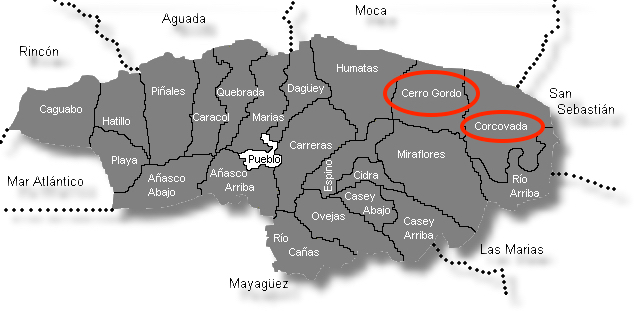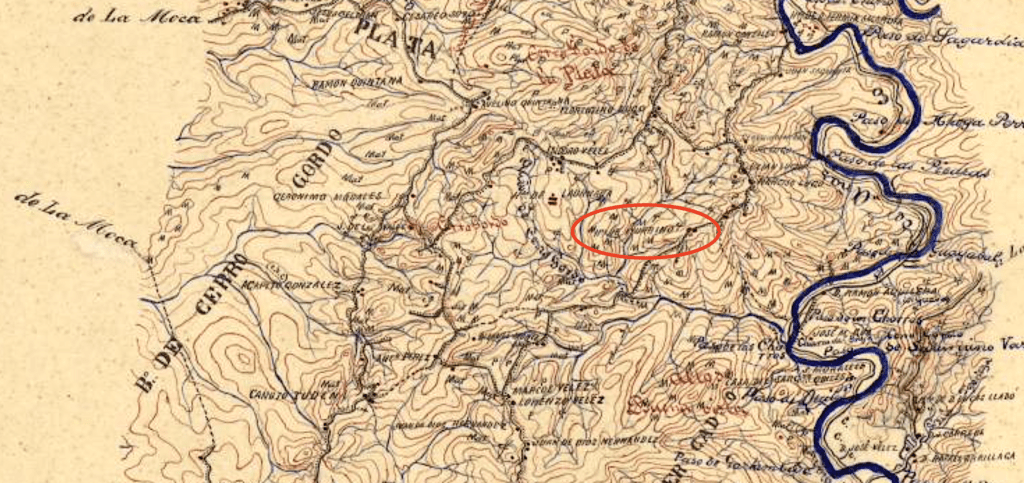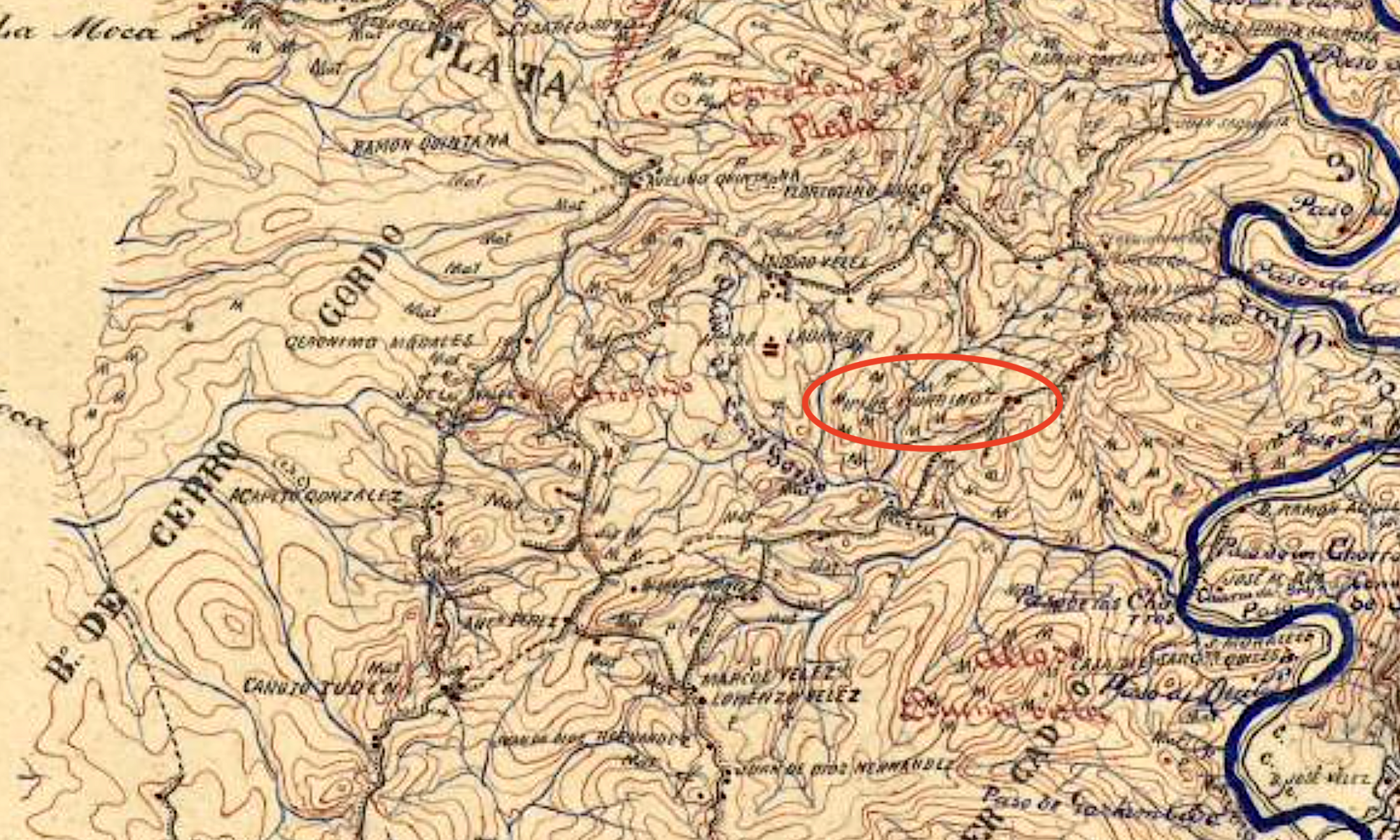Events on the way to freedom
In my recent blog post Yturrino: Looking at a collateral line, I had questions about what kind of business Felipe Iturrino Arzua (1811 -1894) of Anasco was in. While I was able to follow some notary documents that described a string of land purchases in different municipalities, it really wasn’t clear what he had invested in.
These land purchases now make more sense after finding him listed in the 1872 Registro de Esclavos. Yvonne Santana Rios’ transcription of Anasco and Cabo Rojo portions of the 1872 volume led me back to searching the FamilySearch database ‘Slave Registers, Puerto Rico, 1863 – 1879 ‘. I still have no name for the hacienda that these individuals worked, and know more or less where it was located, in barrio Cerro Gordo, Anasco. Yturrino and his family lived in barrio Corcobada to the east of Cerro Gordo, and later in a house in barrio Pueblo.

In barrio Cerro Gordo, Anasco, Yturrino enslaved over 20 people, whose cedulas are receipts for the transfer of ownership from the individual slave holders to the colonial government, and they received 120 pesetas per document. The status change to libertos (freedmen or freedwomen) meant rights were established over time.
According to the terms of the Moret Law, these men, women and children entered a contract to work for their former enslavers or for a different plantation owner. They received no pay, but their freedom at the end of three years. For the youngest, this process of manumission lasted until 1886.
Labor: de Esclava/o a Liberta/o
There were a range of tasks, however few were dependent on women becoming domestics in elite households, or took in laundry, or were dress makers. The majority of enslaved women worked as Labradoras, field laborers alongside men. This ran contrary to the ideal of an enslaved person that circulated in prints and paintings, often depicted as male. Men worked as cooks, carpenters and mostly as field laborers in the sugar centrales that grew after the Spanish American war, and women’s labor shifted to the domestic.
While the categories for labor in the documents for the Registro de Esclavos are few, these do not give a precise idea of the range of tasks that a person had, nor how expert they had become. Cerro Gordo was elevated land, better suited for coffee cultivation, and this is likely the crop that Yturrino’s enslaved workers were raising. Given the patterns of inheritance, there is a high probability that the Hacienda de Iturrino in the 1893 Military Map for Anasco to San Sebastian is the same location as in 1870, situated near the streams in the hills that ran between Anasco and Moca.

Say Their Names: Enslaved families, children, locations
Below is a list of 20 persons listed on cedulas from 1868 on which D. Felipe Yturrino y Arzua appears as dueno (owner). The oldest was Agustin an 80 year old man born in Africa; the youngest was 2 year old Josefa, born in Cerro Gordo, one of the children of Evangelista and Vicenta. Nearly half of those enslaved were children.
The few families I could trace to the Registro Civil opted to take a different surname; not one kept Iturrino as a surname. Some moved to Mayaguez in the years that followed. With the collapse of coffee prices after the 1870s, sugar plantations soon dominated the landscape.
Should these names be familiar to you, please feel free to reach out.
Discover more from Latino Genealogy & Beyond
Subscribe to get the latest posts sent to your email.


Thoughtful of you to consider visualizing our enslaved families, many of us are looking for slave descendants, I can only think of my dear cousin’s claim:
“YO AUN NO HE PODIDO CONECTAR LOS FELIU FONT MENDEZ CON
MI ABUELA MATERNA FRANCISCA FONT MENDEZ.SOLO SE QUE LOS ESCLAVOS A VECES LE PONIAN A SUS HIJOS LOS NOMBRES DE SUS AMOS .HAY COSAS DEL PASADO QUE NO PUEDO CONECTAR TODAVIA.SIEMPRE QUE LE PREGUNTE A MAMY SOBRE SU MADRE ELLA ME DECIAQUE SE LLAMABA FRANCISCA FONT MENDEZ ,HIJA DE PEDRO FONT Y FELICITA MENDEZ.TAMBIEN ME HABLABA DE SU TIA PAULA FONT Y QUE ESTABA CASADA CON JUAN BAUTISTA ROMAN.DECIA QUE UNA QUE ERA LA ESPOSA DE UN HIJO DE LA SRA. DONDE ELLA VIVIA EN S.S. ME REFIERO A DONA CLAUDINA JIMENEZ GONZALEZ{un hijo de ella},ESTABA CASADO CON UNA HERMANA DEL ESPOSO DE PAULA FONT.
EN LA DEFUNCION DE MI ABUELO MATERNO PEDRO FONT DICE QUE TENIA 3 HIJOS:FRANCISCA{que es mi abuela materna},PAULA Y ANTONIO.SOBRE ANTONIO FONT,DE ESTE TIO DE MAMY YO NO TENGO NADA.SI EN ALGUN MOMENTO ENCUENTRO ALGO SABES QUE TE LO ENVIARE.”
Thanks so much for sharing this– it’s these oral histories that can help fill in the tree. Pedro Font was one of the children of Rafaela Font born about 1833 and who died in Bo. Norzagaray, San Sebastian on 3 Aug 1897. She had the following children: Tomas (ca 1850-1908), Jose Felix (1851-1888), Pedro (1853-1918), Natalio (1863-1887) & Antonia Font (1864-1914).
Rafaela was single, and her age is elevated on her death certificate. Her children married into Iriarte, Nieves, Chico, and Perez families. What is unclear is when Rafaela Font was emancipated or if she, like so many bought her freedom. There may be other hints for the paternal line via DNA matches. This work has to be done collaboratively since fragments need to be shared in order to fill in the relationships.
There is another female headed line, that of Marcelina Font, who is mentioned in the San Sebastian parish records for the baptisms of her children. She is identified as ‘esclava de Don Feliu Font’ and was born in Africa about 1820. She had three children, Pedro Domingo, Maria Marta and Bautista born between 1836-1857. Maria Marta Font was the mother of Evaristo Font Acevedo (1868-1928) whose wife Rosalia Cortes Perez (1864-1906) were the parents of your cousin’s great aunt Paula Font Cortes. My connection comes in through Matilde Font (1865-1951) + Nicolas Babilonia Hernandez (1858-1908).
It seems that there would be a number of enslaved persons associated with the family given that Feliu Font de Celis Bas (b.ca 1800, San Feliu de Guixols Gerona- 1855 Aguadilla) and his wife Rosa Medina Lopez (1807-1855) had 11 children from the 1820s-1850s. He had a son Feliu Font Medina (1835-1908) in San Sebastian.
I don’t have the name of their plantation and they seem to have gotten out of business before the 1860s. A cousin we share, M. Torres has shared information with me as we have been researching the enslaved Font descendants. Right now it’s from the careful parish transcriptions from San Sebastian that she has shared that provides the earliest documents on these families. So far, I haven’t seen the notary documents, which are in part, one of the missing pieces here that may provide more context for the lives of Rafaela Font & Marcelina Font’s descendants.
All of this are reasons why the data on the enslaved in Puerto Rico is in need of a centralized database.